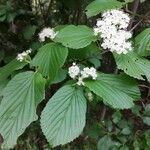Shrubs, deciduous, to 5 m tall. Bark light brown. Branchlets of current year grayish brown, densely bristlelike hairy and stellate-pubescent; branchlets of previous year dark purple-brown, terete, sparsely hairy or subglabrous, with dispersed, small, rounded lenticels. Winter buds ovoid, 3-5 mm, acute, with 2 pairs of separate scales; scales densely bristlelike hairy and stellate-pubescent. Leaves always opposite, not clustered at apices of branchlets; stipules absent; petiole green, robust, (2-) 10-30 mm, stellate pubescent or simple hairs less than 1 mm; leaf blade green when young, broadly obovate, obovate, or broadly ovate, 3-10(-13) × 2-7(-11) cm, papery, abaxially yellowish forklike pubescent and stellate-pubescent, usually with dispersed yellowish or nearly colorless transparent glandular dots, adaxially adpressed hairy, midvein raised abaxially, lateral veins 6-8-jugate, pinnate, straight or slightly arched, branched, ending in teeth, conspicuously raised abaxially, impressed adaxially, veinlets transverse, slightly raised abaxially, impressed adaxially, not lobed, base rounded to obtuse or slightly cordate, sometimes cuneate, with 1-3 circular glands on both sides of midvein near base, margin serrate, apex acute. Flowers appearing after leaves; inflorescence a compound umbel-like cyme, at apices of short branchlets with a pair of leaves, 4-10 cm in diam.; rays whorled; first node of inflorescence with 5 rays, dense, densely bristlelike hairy and stellate-pubescent, without large sterile radiant flowers; peduncles 1-2(-4) cm; bracts and bracteoles deciduous, leaflike, green, lanceolate, hairy. Flowers on rays of 3rd and 4th orders, fragrant, shortly pedicellate or sessile. Calyx green; tube narrowly tubular, ca. 1 mm, stellate-pubescent; lobes ovate, ca. 0.5 mm, ciliate, apex obtuse. Corolla white, rotate, 5-8 mm in diam., stellate-pubescent; tube ca. 1.5 mm; lobes spreading, orbicular-ovate, 1.5-2.5 mm, ca. as long as wide, apex rounded, margin entire. Stamens conspicuously exceeding corolla, inserted at base of corolla; filaments 4-6 mm; anthers yellow-whitish, broadly elliptic, small, ca. 1 mm. Styles exceeding calyx lobes; stigmas 3-lobed. Fruit maturing red, ellipsoid-ovoid, 6-8 × 4.5-6.5 mm, base rounded, apex rounded, glabrous; pyrenes compressed, ovoid, 5-6 × 4-5 mm, with 2 shallow dorsal grooves, and 3 shallow ventral grooves, apex rounded. Fl. May-Jul, fr. Sep-Nov. 2n = 18*.
More
A bushy shrub. It loses its leaves during the year. It grows 3 m tall and spreads 2.4 m wide. The leaves are large and rounded or oval. They have teeth along the edge. They turn red in autumn. The flowers are creamy white and star shaped. They occur in clusters. The fruit are oval and bright red.

